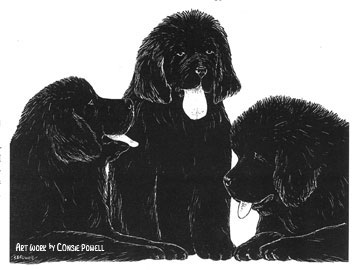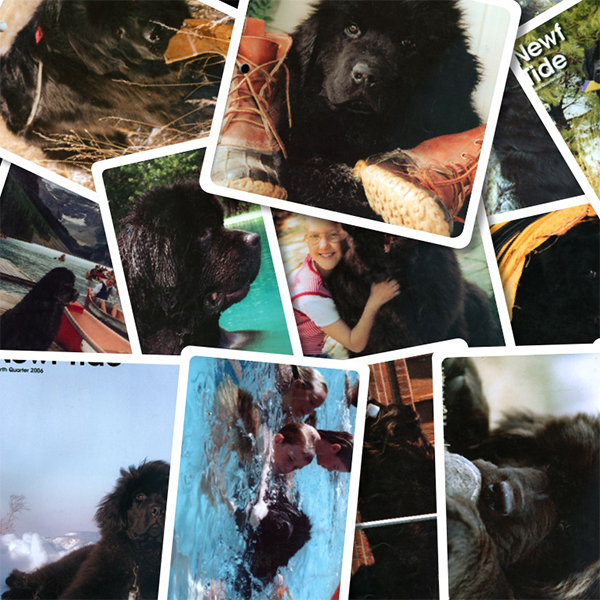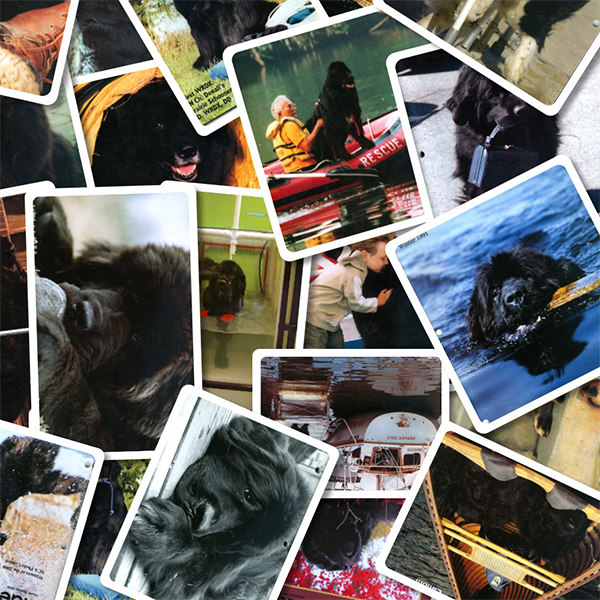by Roger Powell
Have you ever heard someone exclaim that Newfies have problems? Have you heard people say that the problems of hip displasia, elbow anomaly, subvalvular aortic stenosis (SAS), and cataracts are insurmountable? Do you think that too many people are breeding dogs of the wrong type? If you find your frustration overwhelming, I think you are looking at our breed in the wrong way. |
 |
We have the grandest breed. Yes, our breed has some important problems, but they can be surmounted with hard work. We can do it! How do I know? I have seen it happen.
Consie and I bought our first Newf, Kaloosit, over 25 years ago. In the early 1970s, the breed had problems, at least two of which are still with us today: hip dysplasia and SAS. The problems we have with hip dysplasia and SAS now, however, are different than the problems we had 25 years ago. When Consie and I bred Kaloosit the first time, we planned the breeding to minimize hip problems. At that time, finding dogs with generations of certified hips behind them was nearly impossible. We bred two healthy dogs from major lines, both of which were structurally sound. Both had had their hips x-rayed and one was certified and the other borderline. Our breeding produced no dogs whose hips certified and it produced one little girl so crippled that we euthanized her at six months.
Euthanizing dogs crippled with hip dysplasia was not uncommon then. I was not alone with the gut-wrenching emotions that accompany saying good-bye to a wonderful puppy while holding her head, especially a puppy I had bred. Well into the 1980s, Newf owners brought dogs to us to evaluate because they moved strangely, or had trouble getting up, or could not go up and down stairs. These concerned owners wanted to know if something was wrong with their dogs and, if so, what. Often, the problem was hip dysplasia.
We do not see such crippled dogs anymore. Are they still produced? Undoubtedly, but not with the frequency they were 25 years ago. Why? Because NewfY people tackled this problem head on. Conscientious breeders acknowledged the huge problem that hip dysplasia presents to the breed and bred away from it.
Our Ishkoodah died this past summer at age 11 and a half. Her hip x-rays were bad, yet she lived a long, active life with minimal problems and her death was un- related to her hips. I find Ishkoodah typical of dysplastic dogs today. Hip dysplasia is seldom a life-limiting infliction now.
Look what we have done for our dogs in 25 years! We have taken a problem that too often left us gut-wrenched, holding the head of a young, beloved dog for the last time, and we have reduced it to discomfort in old dogs. I feel good about this. Can we relax and contemplate our laurels? Absolutely not. If we are not vigilant, hip dysplasia will rear its ugly head high again. We must continue to breed away from hip dysplasia and to make every effort to eliminate it completely from our breed.
A similar story exists for SAS. When we bought Kaloosit, we heard stories of dogs six months old dropping dead unexpecredly while walking across the yard or when fetching a stick. SAS was not well understood by Newf owners then, and checking hearts was not yet the standard. Look where we are now. Research labs at major veterinary schools are vying to find a genetic marker for SAS. With a genetic marker for SAS, the door opens to eliminate SAS completely. Even without a genetic marker, we have changed the way SAS regularly raises its ugly head. No longer do stories abound of dogs dropping dead. Instead, the worst SAS stories are about dogs that are thought to be SAS-free and are bred, but actually have SAS so mild that it is difficult to diagnose. These dogs produce puppies with SAS that can be diagnosed but that will not kill them. Good breeders take the afflicted dogs out of the breeding pool. Like hip dysplasia, SAS is capable of returning to the breed in its tragic form. With hard work, continued vigilance, and perhaps with the help of a genetic marker, we must strive to eliminate it completely.
What about elbows? Sure, at least two major genetic problems affect the elbows of our wonderful dogs today: elbow dysplasia and elbow anomaly. What can we do? Tackle the problems head on. Elbow dysplasia appears to be polygenic, like hip dysplasia. Continued breeding away from the problem will slowly but surely decrease its prevalence. Elbow anomaly might be genetically simpler. Research underway right now may provide genetic information that can show us how to eliminate elbow anomaly from our list of breed problems.
And what about type? Choose your least favorite type. Isn't it terrible? Isn't it ruining the breed? Are we faced with unsurmountable problems today related to bad type, or a single type, predominating? I am not convinced. I remember people complaining 25 years ago that the Little Bear type had ruined the breed: Little Bear Newfies were too small and judges only looked at dogs with Little Bear type. Sound familiar? Little Bear Kennels produced some great dogs and most of the good dogs of today have Little Bear dogs in their pedigrees. Did Little Bear ruin the breed? Not on your life.
Popular types come and go, just like fashion. My grandfather, a tailor, noted that every fashion popular during his lifetime had been popular at one time or another before he was born. He watched tight pants come and go. He watched baggy pants come and go. We watched pants be worn at the waist and pants be worn on the hips. Before he died, he even saw bell-bottoms reach the masses. Today, what fashion is not accepted? I can walk through the nearby mall or across the college campus in town and see narrow pants and baggy pants, pants on the hips and pants at the waist. They have all gone and come round again.
Popular types for our breed have changed and will continue to change through time. The only thing that must not change is the strength of our breed Standard. As long as our Standard describes a dog capable of doing the jobs for which our breed was developed, then types can come and go with no long-term consequences. We must take care, however, not to let quirks of one type become incorporated into our thinking and interpretation of the Standard.
Kaloosit's two center, lower incisors dropped as she aged, a characteristic common in her lines to this day. I find such dropped teeth endearing. Some people say that this bite is acceptable, but it is a tooth anomaly and it is not a perfect bite. It should never be considered acceptable. My most recent Illustrated Guide to the Standard calls it a minor deviation. Despite the fact that I find it endearing, we must breed away from it, while keeping it in context. Similarly, other problems that become associated with a particular, common type can not be accepted simply because they are common. Just because a popular type today migh toe in slightly, or be slightly cow hocked, or have a slightly undershot bite, we have no reason to accept these problems. We must work to eliminate them.
How must we deal with our breed's problems? We must confront them straight on and work to eliminate them, while keeping our eyes open for new problems as they present themselves. The work will never end because new problems will arise, but we can continually make progress. We know we can make progress because we have made progress over the past 25 years. We can reduce the problems of our breed and thereby enrich the lives of our wonderful dogs.
In the end, however, no matter what problems your dog may or may not have, give her a hug from me.
reprinted from NewfTide 1999

